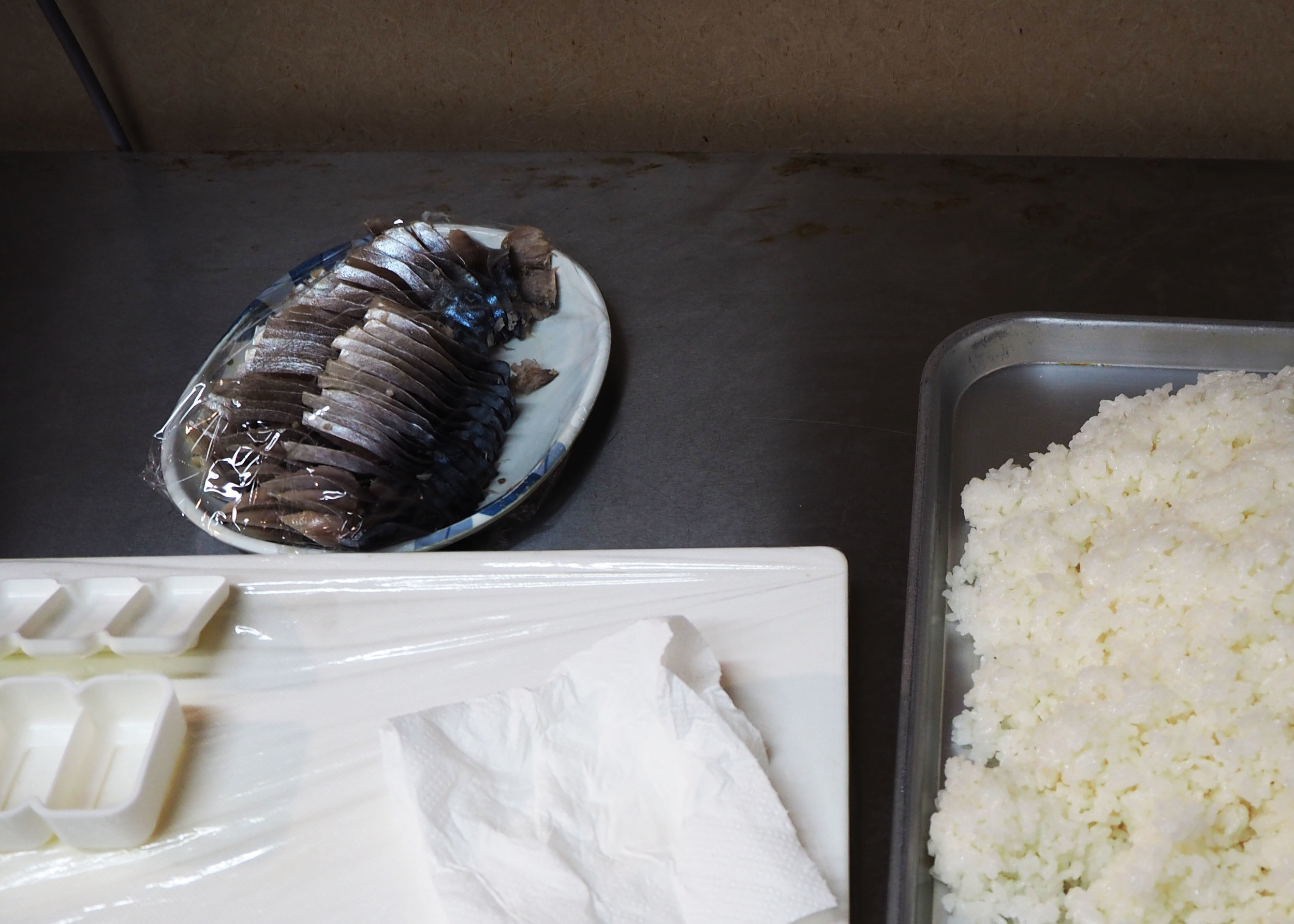(Please scroll down for the English version.)
圧し、包む作業
地元の伝統食品である柿の葉寿司について聞きたいと思い、川上村西河の徳岡さんを訪れた。「圧してみる?」と徳岡さんは温かく微笑み、お店の奥へ案内してくださった。僕は手袋にお酢をつけ、型の底に鯖を一つずつ入れた。また手袋にお酢を少しつけ、型がいっぱいになるまでご飯を鯖の上に乗せた。型の蓋を閉め、体重を使いながら、両手で型を強く圧した。蓋を開け、型を裏返してみたら、5個の鯖寿司が綺麗に並んでいた。お店の前に戻り、お寿司を柿の葉で包む作業に入った。両手の何本かの指を順番にゆっくり動かしながら、徳岡さんは一個を包み、木の箱に入れた。僕は彼の手を真似しようとしたが、最初に指が思うように動かなかった。四、五個目からリズムができ、「右、左、右」の作業に夢中になった。あっという間に木の箱がいっぱいになった。
川上村の柿の葉寿司は日本遺産として認定されて、国籍を問わず観光客に愛されている。吉野山が観光客で賑わっている桜や紅葉の季節に、徳岡さんは一日に早朝より夕方までかなりの量を作る。冬も休まずに、徳岡さんは一年中、鯖と鮭の寿司を一つ一つ圧し、柿の葉で包む。保存食である柿の葉寿司は昔から塩で辛かったが、徳岡さんは現代の好みに合わせ、塩分を控えめにしている。「やっぱり『おいしい』や『口に合う』と言われたら、嬉しい」と徳岡さんは一個の寿司を柿の葉で包みながら言った。
僕は柿の葉寿司を何個も持って帰り、レコードを流し、美味しくいただいた。川上村の家庭はみんな柿の葉寿司を作れるとよく言われる。当然かもしれないが、僕の実家で柿の葉寿司を作らない。僕は自分の手で寿司を圧し、柿の葉で包み、家で食べることによって、みんなの生活を少し垣間見たような気がする。一個を作るためどのぐらいの手間がかかるかを実感したおかげで、これから食べる柿の葉寿司がさらに美味しくなる。
Press and Wrap Work
As I wanted to ask about the traditional local dish, kakinohazushi, I visited Mr. Tokuoka in the Nishigawa district of Kawakami Village. “You wanna try pressing it?” He asked me with a warm smile, and led me to the back of the shop. I wet my gloves in vinegar and placed individual pieces of mackerel on the bottom of the shaping mold. I once again wet my gloves with vinegar and loaded rice on top of the mackerel until the mold was full. I closed the lid, and using my body weight, pressed down strongly with both hands. When I opened the lid and flipped the shaping mold over, five pieces of sushi were lined up perfectly. We went back to the front of the shop and got to work wrapping the sushi in persimmon leaves. Slowly moving multiple fingers of both hands in a specific order, Mr. Tokuoka wrapped up a single piece of sushi and placed it in a wooden box. I tried to imitate his hands, but at first my fingers wouldn’t move how I wanted them. I developed a rhythm around the fourth of fifth piece of sushi, becoming absorbed in the “right, left, right” work. Before we knew it, the box was full.
The kakinohazushi of Kawakami Village is a recognized Japan Heritage cultural property, and is loved by many tourists regardless of citizenship. When Mt. Yoshino is busy with tourists in the cherry blossom and colored leaves seasons, Mr. Tokuoka makes a ton of sushi from the early morning into the evening almost everyday. Without taking any time off in the winter, Mr. Tokuoka continues to press mackerel and salmon sushi, then wrap them in persimmon leaves year-round. As a preserved food, kakinohazushi was originally very salty, but Mr. Tokuoka has catered to modern tastes, and tries to go light on the salt. “Of course I’m happy when people say, ‘It’s delicious’ or ‘This is just how I like it.’,” he told me as he wrapped a piece of sushi in a persimmon leaf.
I took home some pieces of kakinohazushi, put on a record, and ate the delicious local specialty. I am often told that most households in Kawakami Village can make kakinohazushi. It might go without saying, but the house I grew up in did not make it. By pressing the sushi, wrapping them in persimmon leaves with my own hands, and finally eating them, I felt like I caught a short glimpse of everyone’s life. Getting a feel for how much work goes into making one piece of sushi, the kakinohazushi I eat from now on will taste even more delicious.




